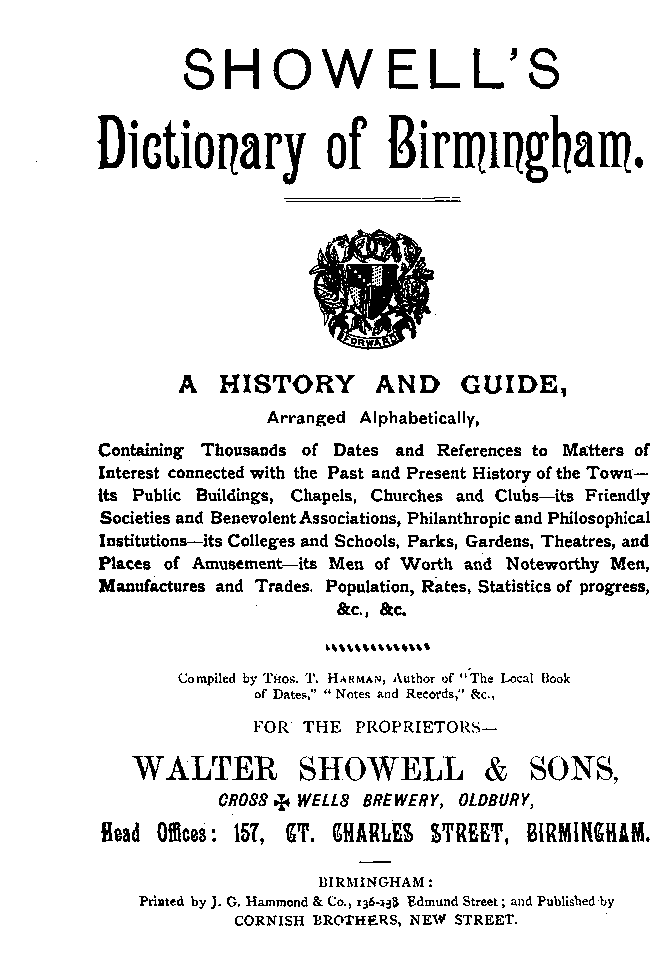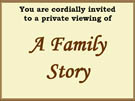
The Project Gutenberg EBook of Showell's Dictionary of Birmingham
by Thomas T. Harman and Walter Showell
This eBook is for the use of anyone anywhere at no cost and with almost no
restrictions whatsoever. You may copy it, give it away or re-use it under the terms
of the Project Gutenberg License included with this eBook or online at
www.gutenberg.net
Title: Showell's Dictionary of Birmingham - A History And Guide Arranged
Alphabetically
Author: Thomas T. Harman and Walter Showell
Release Date: December 26, 2004 [EBook #14472]
Language: English
Character set encoding: ISO-8859-1
*** START OF THIS PROJECT GUTENBERG EBOOK SHOWELL'S DICTIONARY OF BIRMINGHAM ***
Produced by Jonathan Ingram, Carol David and the PG Online Distributed
Proofreading Team
Transcriber's note: There are small sections where the print is
missing from the original. Missing words have been marked [**]. Minor
obvious typographical errors have been corrected.
Where it has not been possible to convert fractions to HTML, they have
been denoted as example: one and 3/5 = 1-3/5.]
SHOWELL'S
Dictionary of Birmingham.
NOTES OF BIRMINGHAM IN THE PAST.
Birmingham to the Seventh Century.—We have no record or
traces whatever of there being inhabitants in this neighbourhood,
though there can be little doubt that in the time of the invasion of
the Romans some British strongholds were within a few miles of the
place, sundry remains having been found to show that many battles had
been fought near here. If residents there were prior to King Edward
the Confessor's reign, they would probably be of Gurth's
tribe, and their huts even Hutton, antiquarian and historian as he
was, failed to find traces of. How the name of this our dwelling-place
came about, nobody knows. Not less than twelve dozen ways have been
found to spell it; a score of different derivations
"discovered" for it; and guesses innumerable given as to its
origin, but we still wait for the information required.
Birmingham in the Conqueror's Days.—The Manor was
held, in 1066, by Alwyne, son of Wigod the Dane, who married the
sister of the Saxon Leofric, Earl of Mercia. According to
"Domesday Book," in 1086, it was tenanted by Richard, who,
held, under William Fitz-Ansculf, and included four hides of land and
half-a-mile of wood, worth 20s.; there were 150 acres in cultivation,
with but nine residents, five villeins, and four bordarers. In 1181
there were 18 freeholders (libere tenentes) in Birmingham
cultivating 667 acres, and 35 tenants in demesne, holding 158
acres, the whole value being £13 8s. 2d.
Birmingham in the Feudal Period.—The number of armed men
furnished by this town for Edward III.'s wars were four, as
compared with six from Warwick, and forty from Coventry.
Birmingham in the Time of the Edwards and Harrys.—The
Manor passed from the Bermingham family in 1537, through the knavish
trickery of Lord L'Isle, to whom it was granted in 1545. The
fraud, however, was not of much service to the noble rascal, as he was
beheaded for treason in 1553. In 1555 the Manor was given by Queen
Mary to Thomas Marrow, of Berkswell.
Birmingham in 1538.—Leland, who visited here about this
date, says in his "Itinerary"—"There be many
smithies in the towne that use to make knives and all manner of
cutlery tooles, and many lorimers that make bittes, and a great many
naylors, so that a great part of the towne is maintained by smithes,
who have their iron and seacole out of Staffordshire." He
describes the town as consisting of one street, about a quarter of a
mile long, "a pretty street or ever I enterd," and
"this street, as I remember, is called Dirtey."
Birmingham in 1586.—Camden in his "Britannica,"
published this year, speaks of "Bremicham, swarming with
inhabitants, and echoing with the noise of anvils, for the most part
of them are smiths."
Birmingham in 1627.—In a book issued at Oxford this year
mention is made of "Bremincham inhabited with blacksmiths, and
forging sundry kinds of iron utensils."
Birmingham in 1635.—As showing the status the town held
at this date we find that it was assessed for "ship money"
by Charles I. at £100, the same as Warwick, while Sutton
Coldfield had to find £80 and Coventry £266.
Birmingham in 1656.—Dugdale speaks of it as "being a
place very eminent for most commodities made of iron."
Birmingham in 1680-90.—Macaulay says: The population of
Birmingham was only 4,000, and at that day nobody had heard of
Birmingham guns. He also says there was not a single regular shop
where a Bible or almanack could be bought; on market days a bookseller
named Michael Johnson (father of the great Samuel Johnson) came over
from Lichfield and opened a stall for a few hours, and this supply was
equal to the demand. The gun trade, however, was introduced here very
soon after, for there is still in existence a warrant from the Office
of Ordnance to "pay to John Smart for Thomas Hadley and the rest
of the Gunmakers of Birmingham, one debenture of ffour-score and
sixteen poundes and eighteen shillings, dated ye 14th of July,
1690."—Alexander Missen, visiting this town in his travels,
said that "swords, heads of canes, snuff-boxes, and other fine
works of steel," could be had, "cheaper and better here than
even in famed Milan."
Birmingham in 1691.—The author of "The New State of
England," published this year, says: "Bromichan drives a
good trade in iron and steel wares, saddles and bridles, which find
good vent at London, Ireland, and other parts." By another
writer, "Bromicham" is described as "a large and
well-built town, very populous, much resorted to, and particularly
noted a few years ago for the counterfeit groats made here, and
dispersed all oven the kingdom."
Birmingham in 1731.—An old "Road-book" of this
date, says that "Birmingham, Bromicham, or Bremicham, is a large
town, well built and populous. The inhabitants, being mostly smiths,
are very ingenious in their way, and vend vast quantities of all sorts
of iron wares." The first map of the town (Westley's) was
published in this year. It showed the Manorhouse on an oval island,
about 126 yards long by 70 yards extreme width, surrounded by a moat
about twelve yards broad. Paradise Street was then but a road through
the fields; Easy Hill (now Easy Row), Summer Hill, Newhall Hill,
Ludgate Hill, Constitution Hill, and Snow Hill pleasant pastures.
Birmingham in 1750.—Bradford's plan of the town,
published in 1751, showed a walk by Rea side, where lovers could take
a pleasant stroll from Heath Mill Lane. The country residences at
Mount Pleasant (now Ann Street) were surrounded with gardens, and it
was a common practice to dry clothes on the hedges in Snow Hill. In
"England's Gazetteer," published about this date,
Birmingham or Bromichan is said to be "a large, well-built, and
populous town, noted for the most ingenious artificers in boxes,
buckles, buttons, and other iron and steel wares; wherein such
multitudes of people are employed that they are sent all over Europe;
and here is a continual noise of hammers, anvils, and files."
Birmingham in 1765.—Lord and Lady Shelburne visited here
in 1765. Her ladyship kept a diary, and in it she describes Mr.
Baskerville's house (Easy Row) as "a pretty place out of the
town." She also mentions visiting a Quaker's to see "the
making of guns."
Birmingham in 1766.—In "A New Tour through
England," by George Beaumont, Esq., and Capt. Henry Disney,
Birmingham is described as "a very large populous town, the upper
part of which stands dry on the side of a hill, but the lower is
watry, and inhabited by the meaner sort of people. They are employed
here in the Iron Works, in which they are such ingenious artificers,
that their performances in the smallwares of iron and steel are
admired both at home and abroad. 'Tis much improved of late years,
both in public and private buildings."
Birmingham in 1781.—Hutton published his "History of
Birmingham" this year. He estimated that there were then living
ninety-four townsmen who were each worth over £5,000; eighty
worth over £10,000; seventeen worth over £20,000; eight
worth over £30,000; seven worth over £50,000; and three at
least worth over £100,000 each.
Birmingham in 1812.—The appearance of the town then would
be strange indeed to those who know but the Birmingham of to-day. Many
half-timbered houses remained in the Bull Ring and cows grazed near
where the Town Hall now stands, there being a farmhouse at the back of
the site of Christ Church, then being built. Recruiting parties
paraded the streets with fife and drum almost daily, and when the
London mail came in with news of some victory in Spain it was no
uncommon thing for the workmen to take the horses out and drag the
coach up the Bull Ring amid the cheers of the crowd. At night the
streets were patrolled by watchmen, with rattles and lanterns, who
called the hours and the weather.
